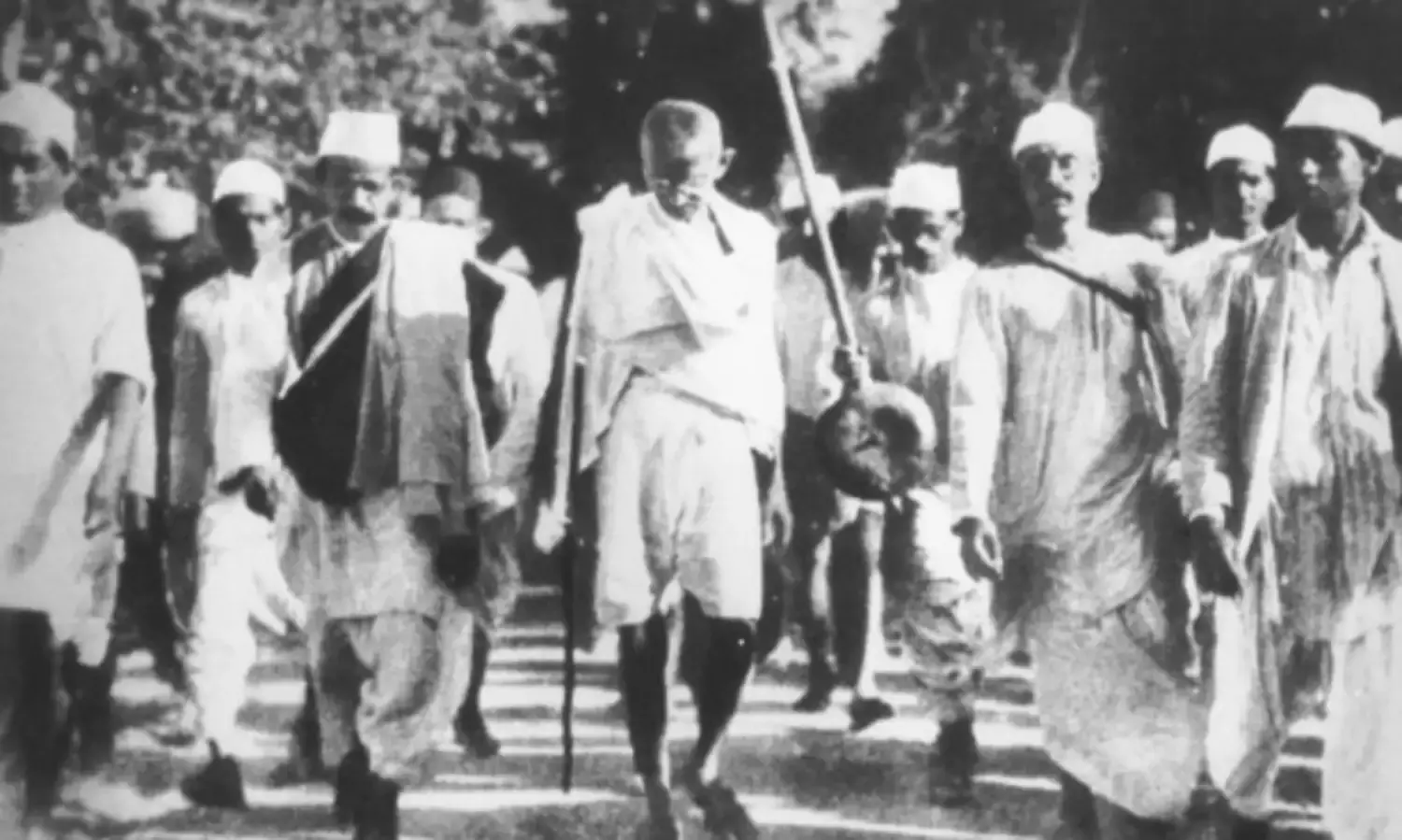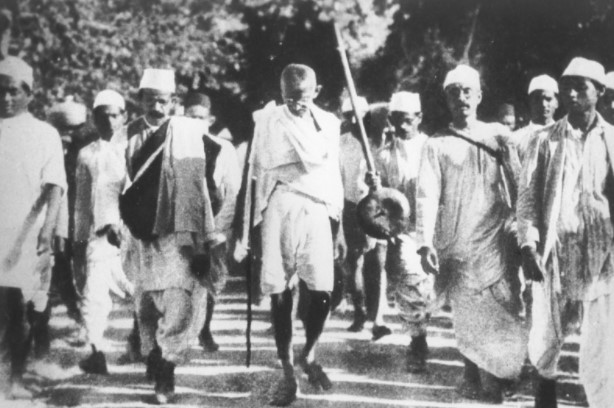Resisting Injustice
‘Christ gave us the goals and Mahatma Gandhi the tactics’

During 1917-1947 for three decades tens of millions of people in India, including a large number of women, were drawn towards a path of freedom struggle whose most non-negotiable precept was that of non-violence. This remains perhaps the biggest non-violent mobilization of people against injustice, which also had reasonable continuity over the longest period. This struggle against what was then the most powerful colonial power in the world was led overwhelmingly by Mahatma Gandhi (1869-1948), although of course there were several other inspiring leaders and colleagues who contributed in a big way.
73 years after he left us, a world troubled by injustice and violence can still learn much from the path of M.K.Gandhi. Prominent leaders like Nelson Mandela and Martin Luther King Jr. have testified to how the path of Gandhi was helpful and inspiring for them, as have the Dalai Lama, U Thant and Barack Obama. In India, in post- independence decades, several struggles of farmers and landless workers, as well as movements for saving rivers and forests, have followed the legacy of Gandhi.
Albert Einstein said, “I believe that Gandhi’s views were the most enlightened of all the political men of our time”. Ho Chi Minh stated, “I and others may be revolutionaries, but we are the disciples of Mahatma Gandhi, more or less.”
The non-violent actions resorted to by Gandhi and his colleagues against injustice were called Satyagraha in Hindi, translated as pleas for truth. Truth is always on the side of justice, hence the struggle for justice is a plea for truth. This moral force is strengthened by the fact that the path of non-violence has no intentions of harming anyone, it is taken only to stop the harm being caused by injustice.
Martin Luther King Jr. said, “Christ gave us the goals and Mahatma Gandhi the tactics.” A satyagraha typically gives the perpetrator of injustice time-bound notice, accompanied with a well-reasoned demand letter, to stop injustice. Failing this, non-violent protests and sit-ins follow, in the course of which a strong campaign is carried out using all democratic avenues to mobilize support. The movement progresses then to higher stages of protest, such as symbolic breaking of unjust laws, non-cooperation with authorities and fasts by some leaders. The room for negotiations remains open, protests are disciplined—no violence, no hatred or abuse.
The power of non-violence is by no means confined to bigger struggles against imperialism. In everyday life the practice of non-violence and training for this can lead to significant reduction in street violence, domestic violence, bullying, child abuse and sexual violence. These can often be the biggest cause of distress in daily life for countless people.
Mahatma Gandhi said that non-violent struggles need even more courage than violent struggles. Freedom fighters fighting this path had to face police attacks and firings, without any counter-violence, apart from serving frequent prison sentences. However when these sufferings were willingly accepted by men and particularly women regarded as most noble in society, this had an electrifying impact on ordinary people who came forward in large numbers to join the freedom struggle. Before Gandhi the struggle led by Congress Party was for the most part an elitist effort (although there were exceptions), but with the advent of Gandhi tens of millions traversed this difficult path.
However struggles which involved jail sentences could not always continue and for continuity of effort and mobilization Gandhi suggested several constructive activities. These included constant efforts to end social discriminations and to promote inter-faith harmony. Women were to have equal rights of education and advancement. They were to be encouraged for a greater social role, in the freedom movement as well as in reforms like reducing consumption of alcohol and intoxicants.
In social reforms Gandhi advocated an approach that would make the reforms acceptable to a very large number of people. Rather than using very strong and radical words, Gandhi often used parts of good traditions to get rid of harmful traditions.
People’s skills and livelihoods being displaced by colonial exploitation were to be protected. One way was to promote hand-spun, hand-woven cloth (khadi) which would protect the livelihoods of spinners, weavers and others. Khadi, moreover, was to be just one aspect or a symbol of a many-sided effort to protect livelihoods.
All these constructive programs also involved a non-violent resistance to violent assaults of various kinds, whether in the form of assaults on livelihood, or social and gender discrimination and injustice. Similarly great importance was attached to resisting the violence of economic exploitation.
Economics, Gandhi emphasized, should be closely integrated to Ethics. He said, “The true value of any society can be found in how it treats its most vulnerable members.” When faced by doubt, he advised policy-makers to decide on the basis of what will be helpful for the poorest and the weakest.
Earth has enough to satisfy need but not greed, he emphasized much before the ecological crisis hit the headlines. Endless consumerism is harmful but basic needs of all should be met. He practiced such community life as will help to meet needs in durable, sustainable, low-cost ways which can be accessible to all, a form of community life in which people can be happy together without yearning too much for material belongings. Physical labor and hand skills should be valued and respected, instead of constant efforts being made to reduce or devalue them.
Rural life can be more conducive for such communities , and should be nurtured instead of progress being equated with rapid urbanization. Such frugal and simple life is more conducive to peace and non-violence, while greed brings conflict, with a tendency to grab the rightful share of others. Education must include all such ethical concerns, including training for peace and non-violence.
In post-independence India several efforts and struggles continued the Gandhian legacy. The gift of land (bhoodan) movement was taken forward by Gandhi’s leading disciple Vinoba Bhave. This involved long marches covering thousands of villages by him and his colleagues, including women, to inspire and request landowners to donate a part of their land for the landless households of the village. In more recent times P.V.Rajagopal, another disciple of Gandhi, has been one of the main inspirations behind demands to implement land reforms including land distribution among the landless.
In ecologically sensitive Himalayan and Western Ghats regions, Chipko and Appiko (hug the trees) movements were organized to protect trees which had been marked for felling. Several such actions by Gandhian activists and villagers culminated finally in government orders to stop commercial tree felling over a much wider area.
Chambal Valley region in Central India was deeply troubled by its extremely violent and revengeful dacoits. Gandhian peace activists approached several of them to surrender and return to a peaceful life. A leading follower of Gandhi Jayaprakash Narain was brought in to bless the entire effort, culminating in the surrender of as many as 200 once-dreaded dacoits within the span of a few weeks.
Gandhi also lives on in his home-country and abroad in the form of numerous smaller struggles that follow his essential precept of non-violence to resist injustice. Former Secretary General of the United Nations U Thant said—Many of Gandhi’s principles have universal application and validity. Romain Rolland wrote, “I have seen here, in Switzerland, the pious love that Gandhi inspired in humble peasants of the countryside and the mountains.”
In a world of increasingly destructive weapons, the importance of the most essential message of non-violence has obviously increased. Martin Luther King Jr. said, “The choice is no longer between violence and non-violence. It is now either non-violence or non-existence.” If non-violence as a way of life can be used in educational programs in a big way, this will help to prepare a strong base, over a few years, for creating a world which is much more receptive to avoiding war and the accompanying arms race.
In addition there are dozens of social problems for reducing which the precept and training of non-violence as a base value will be very useful. Martin Luther King said—“Mahatma Gandhi has done more than any other person in history to reveal that social problems can be solved without resorting to primitive methods of violence.” He further said—“If humanity is to progress, Gandhi is inescapable. He lived, thought and acted, inspired by the vision of humanity evolving toward a life of peace and harmony.”
Some people say that Gandhian methods do not appear to be very practical in the more complex present world. Well, this was said to Gandhi in the early stage of his work also. His response will give heart to those who believe in nonviolent resistance to injustice—“First they ignore you, then they laugh at you,then they fight you, then you win.”




